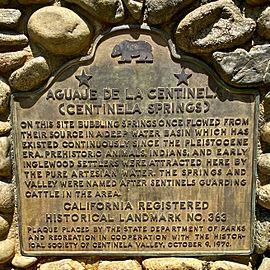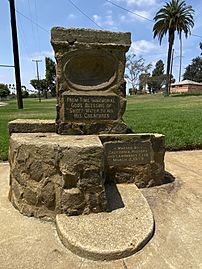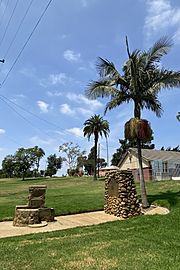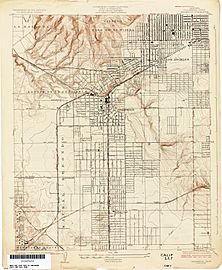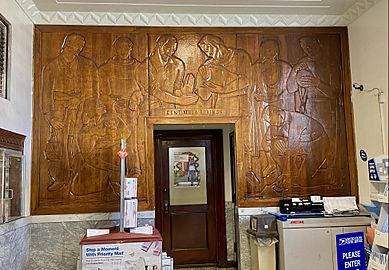Aguaje de Centinela facts for kids
Quick facts for kids Centinela Springs |
|
|---|---|
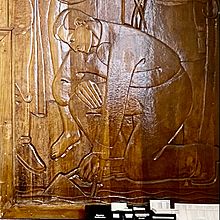
Detail of “Centinela Springs” wood carving
|
|
| Location | Centinela Park, Inglewood, California |
| Reference no. | 363 |
The Centinela Springs (also known as Aguaje de Centinela) was a very important natural spring. It provided fresh water for a long time to the area that is now Inglewood and southwest Los Angeles in Southern California. People, animals, and farms all relied on its water.
Contents
Remembering Centinela Springs
Today, you can find two special markers that remember the Centinela Springs. They are located in Edward Vincent Jr. Park in Inglewood, California. The springs themselves no longer flow from the ground.
The Older Monument
One monument was built a long time ago, during the Great Depression. A talented artist named Archibald Garner designed it. He also created a beautiful wood carving called “Centinela Springs.” This carving is at the Hillcrest Avenue post office.
The older monument was first designed to have separate drinking fountains. One was for people, one for horses, and one for dogs! The words on this marker say:
- FROM TIME IMMEMORIAL GOD'S BLESSING OF SWEET WATER TO ALL HIS CREATURES
- MARKED BY CALIFORNIA HISTORY AND LANDMARKS CLUB MARCH 2, 1939
The California Landmark
The second marker was placed 30 years later, in 1976. It is part of the official California Historical Landmark system. This marker tells us more about the springs:
- AGUAJE DE LA CENTINELA (CENTINELA SPRINGS)
- ON THIS SITE BUBBLING SPRINGS ONCE FLOWED FROM THEIR SOURCE IN A DEEP WATER BASIN WHICH HAS EXISTED CONTINUOUSLY SINCE THE PLEISTOCENE ERA. PREHISTORIC ANIMALS, INDIANS, AND EARLY INGLEWOOD SETTLERS WERE ATTRACTED HERE BY THE PURE ARTESIAN WATER. THE SPRINGS AND VALLEY WERE NAMED AFTER SENTINELS GUARDING THE CATTLE IN THE AREA.
- CALIFORNIA REGISTERED HISTORICAL LANDMARK NO. 363
- PLAQUE PLACED BY THE STATE DEPARTMENT OF PARKS AND RECREATION IN COOPERATION WITH THE HISTORICAL SOCIETY OF CENTINELA VALLEY, OCTOBER 9, 1976.
This marker explains that the springs came from a deep underground water source. This source has been there since ancient times! Animals, Native Americans, and early settlers all came here for the clean water. The area was named "Centinela" because it means "sentinel" or "guard." This refers to guards watching over cattle nearby.
History of the Water
The Centinela Springs were known to Native Americans for a very long time. In 1837, a large piece of land was given out. It was named Rancho Aguaje de la Centinela after these important "sentinel of waters." Aguaje means "water hole" in this case.
For most of the 1800s, the spring water was used for animals and farming. Water from the springs was even sent through a small canal. This canal helped water sheep and other plants.
Water Levels Change
In the late 1800s, there was a lot of water underground. Water flowed easily from wells and springs. But as more people moved to areas like Inglewood and Long Beach, they started using more and more water.
An old report from 1888 described the springs. It said they naturally flowed a good amount of water. Later, they were developed to provide even more. The water was first used to water a large orchard. Then, it was piped to a reservoir. From there, it was sent to the town of Inglewood.
By the early 1900s, people started drilling shallow wells. This was because the water on the surface was decreasing. A report from 1901 showed that Inglewood had a water supply from springs and wells. It used pumps to send water to a large reservoir.
Growing City, More Water Needed
The city of Inglewood was officially formed in 1908. By 1910, about 1,536 people lived there. The demand for water kept growing.
Around the early 1910s, a water company even thought about selling bottled water from Centinela Springs! They wanted to build a clean, tiled area around the spring. People could then see how the water was bottled.
But by 1936, the water level had dropped a lot. The springs used to gush out of the ground. Now, the water was 150 feet or more below the surface. People were worried that old trees were dying because of the lack of water.
By the early 1930s, too much water was being taken from underground. This caused saltwater from the Pacific Ocean to flow inland.
In 1938, it was reported that the water level had dropped even more. It was 160 feet below the surface and dropping about four feet each year.
By 1940, Inglewood's population had grown to over 30,000 people. This meant even more demand for water. In 1949, Inglewood joined the Metropolitan Water District of Southern California. This helped the city get water from other sources. It also meant they stopped taking so much water from their own underground supply.
Today, the wells in the park are not deep enough to reach any remaining water from the original springs.
Gallery
-
New Deal-era wood carving “Centinela Springs,” Hillcrest Avenue post office


